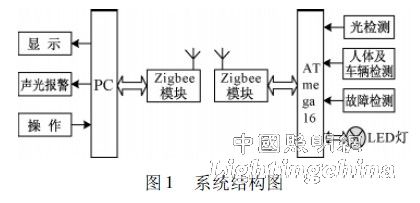introduction
The street lighting system controlled by time control and illumination control has the phenomena of short service life, large management overhead, waste of power, remote monitoring and low efficiency of fault repair [1]. With the improvement of people's quality of life and the advancement of science and technology, the requirements for urban street lamps are getting higher and higher, not only requiring safety, energy saving, and convenient maintenance, but also requiring them to beautify the night scene and highlight the charm of the city; for example, the installation of Shanghai Boyuan Wireless landscape lighting, adding a lot of color to its night.
At present, street lighting systems at home and abroad are developing towards energy saving, single lamp control and remote monitoring [2]. Based on wireless network technology, this paper designs a set of street lamp control training system realized by Zigbee technology. The system can realize remote real-time monitoring and data acquisition and storage of street lamps.
2 system hardware design
The system consists of a street light node installed on the street light pole, a wireless network and a monitoring center. The structure is shown in Figure 1. The street light node and the monitoring center need to be equipped with a wireless communication module.

The AC power is changed to 12V DC through the rectifier bridge KBP210, which provides power for the LED drive circuit and fault detection circuit, and the power can reach 40W. The 12V DC power supply passes the LM2596-5. 0 Integrated three-terminal regulator outputs 5V DC power supply, and the output current is the largest. Up to 3A, with excellent linearity and load regulation, providing power to Zigbee modules, microcontrollers and other peripheral circuits.
2. 1 wireless network
The wireless network uses Zigbee technology to enable reliable communication between the street light work site and the system monitoring center. This technology is mainly used in various electronic devices with low data transmission rate and short-distance transmission. It is very suitable for industrial control, environmental monitoring and other occasions, and has the characteristics of low power consumption, low cost and low complexity. The Zigbee module of this system uses the CC2530 system-on-chip as the core of the control circuit, with 256KBFLASH. In the receive and transmit modes, the current loss is lower than 25mA and 34mA respectively. The module power supply is supplied with 5V from an external regulated power supply to ensure stable operation of each node for a long time.
According to the characteristics of the street lamp system, the network adopts a tree connection to flexibly expand the node and the ad hoc network. The Zigbee module connected to the serial port RS232 of the PC is a network coordinator, which plays the role of organizing, managing the network and issuing commands. When a node is added to the network, it assigns an address to the new node, so there is no power failure or low power consumption. The Zigbee module connected to the serial port of the street lamp unit is a router, which acts as a repeater, can send and receive data and can also forward data, and undertakes the task of communicating with the host computer and adjacent nodes.
2. 2 street light nodes
The street light node is composed of a street light controller, a power module and a Zigbee module, which completes the processing of field data and control commands, and controls the LED light switch and dimming tasks.
The streetlight controller selects the high-performance, low-power 8-bit AVR microprocessor ATmega16 as the core component. The input/output port of the MCU can be freely set, and the driving capability is strong. It combines multiple devices and multiple functions, greatly reducing The use of peripheral devices reduces the complexity of the circuit [3]. The peripheral circuits of the controller include circuits for signal detection, lighting drive, and fault detection.
The signal detecting portion is composed of a photoresistor circuit and a pyroelectric infrared sensor circuit. The photoresistor 5537 is used for detecting ambient light to control the brightness of the light. The pyroelectric infrared sensor DYPME003 is adjustable from 0 to 7 meters to determine whether there is a pedestrian or vehicle passing, and adjust the brightness of the light according to the set value.
Considering the high efficiency and energy saving of LED street lamps and their increasing application, LEDs are used as light sources and driven by XN2115 chips. The system uses 4 LEDs of 1W, 3.2 to 3. 6V. The street lamp fault detection signal is taken from the voltage of the SW point of the XN2115 chip, and the voltage of the point is compared with the reference voltage of the voltage comparator after passing through the large capacitor flat wave, and the high and low levels of the comparison result are sent to the single chip processing, and the fault information is sent. The function of the fault alarm and position display is realized to the upper computer.
The streetlight node uses 5V and 12V DC. Turn 220V AC into 12V DC through rectifier bridge KBP210, provide power for LED drive circuit and fault detection circuit, power up to 40W; 12V DC power supply through LM2596-5. 0 integrated three-terminal regulator output 5V DC power supply, output With up to 3A of current, it has excellent linearity and load regulation characteristics to power Zigbee modules, microcontrollers and other peripheral circuits.